If you’re looking for easygoing bonsai, I’ve got your back! The Jade (Portulacaria Afra) and Ficus Bonsai are absolute gems for those of us who dread complicated care routines. These plants thrive on neglect—seriously! Just give the Jade some sun and water when it dries out, while the Ficus prefers slightly moist soil. It’s like they can sense when you’re busy. Curious about more trees that fit this low-maintenance vibe? There’s so much to explore!
Quick Takeaways
- Ficus Bonsai is forgiving, tolerating minor care lapses while thriving in various light conditions.
- Chinese Elm is resilient to leaf burn, requires consistent moisture, and adapts well to indoor and outdoor settings.
- Little Ollie Olive and Boxwood Bonsai offer dense foliage with minimal watering, perfect for low-maintenance environments.
- Dwarf Umbrella Tree is visually appealing, thrives in bright light, and requires only moderate watering and daily misting.
- Jade (Portulacaria Afra) is low-maintenance, thriving on neglect, making it ideal for busy lifestyles.
Jade (Portulacaria Afra)
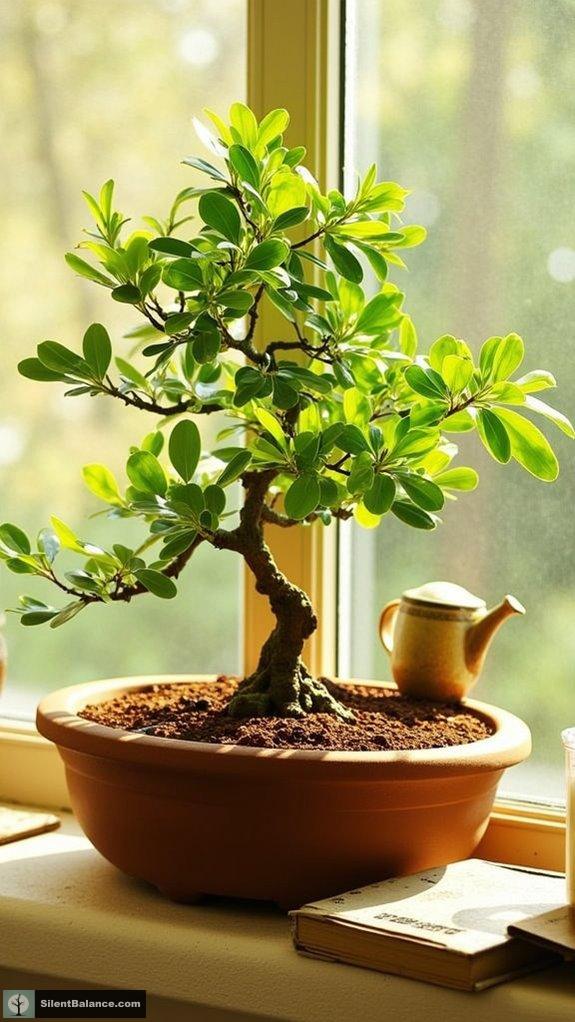
When you think of a bonsai tree that practically takes care of itself, Jade (Portulacaria afra) might just be the superstar on your list!
This little gem loves bright light, soaking up the sun like it’s on vacation. I’ve found that watering only when the soil’s dry about an inch deep keeps my Jade happy. Ideal placement near south or west-facing windows enhances its growth, helping it thrive even more. Additionally, bonsai trees, including Jade, hold deep cultural significance in various traditions, symbolizing harmony and balance.
And guess what? It thrives on neglect—perfect for busy folks!
Give it well-draining soil and a shallow pot, and this beauty will reward you with vibrant, plump leaves.
Just keep in mind, no overwatering; we don’t want our Jade taking a dip in root rot!
With a quick trim for shaping, you’ll have a striking bonsai that’s as easygoing as your favorite Sunday morning.
Who wouldn’t want that?
Ficus Bonsai

Ficus bonsai is truly one of the most forgiving tree species in the bonsai world, making it a fantastic choice for both novices and seasoned green thumbs alike.
I mean, who doesn’t love a tree that can handle a little hiccup in its care routine? Water it when the topsoil’s slightly dry, and don’t stress too much if you forget sometimes. Monitoring soil moisture levels ensures you’re meeting its watering needs effectively! Additionally, Ficus trees can adapt to a variety of light conditions, ensuring they remain resilient even in less-than-ideal environments.
Pro tip: double-water to guarantee the roots get a good drink!
Bright, indirect light for around six hours daily keeps your Ficus thriving, and they’re pretty chill about humidity, too.
Plus, a good trim every now and then helps shape it up.
Let’s face it, no one needs a wild Ficus crashing the bonsai party!
Ready to cultivate some tranquility?
Chinese Elm (Ulmus Parvifolia)
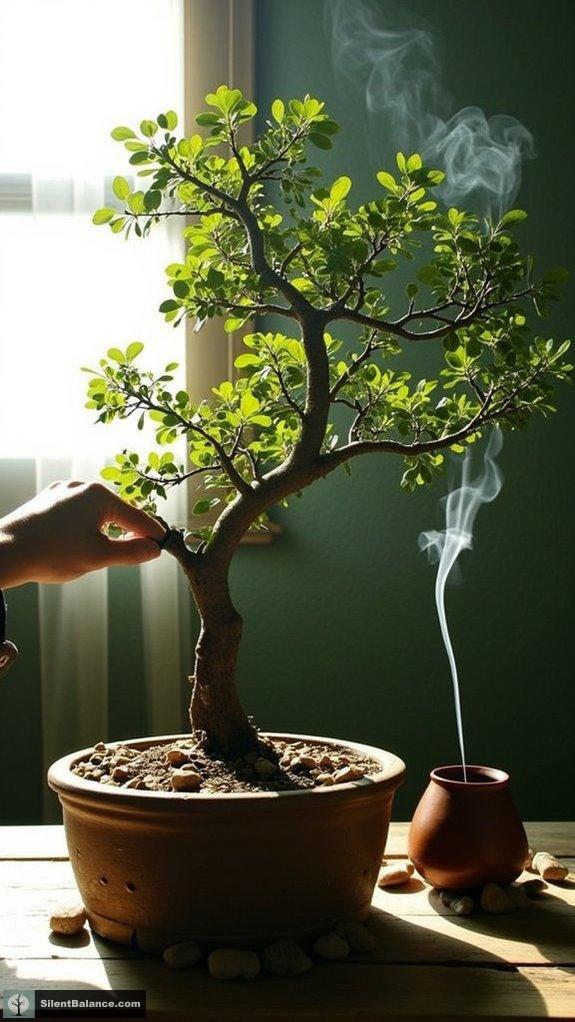
Looking for a bonsai that combines resilience with a touch of elegance?
The Chinese Elm (Ulmus parvifolia) is your perfect match. This little gem thrives in full sun or partial shade, leaving you worry-free about leaf burn.
Watering’s a breeze too—just keep that soil consistently moist, checking when the top layer feels dry.
Pruning? It loves a good trim, so feel free to shape it up!
With a friendly nature, it also enjoys outdoor life, soaking up sunshine in the summer, while indoors during the winter.
You’ll find that repotting every few years keeps it happy, ensuring strong roots.
Broadleaf Evergreen Species
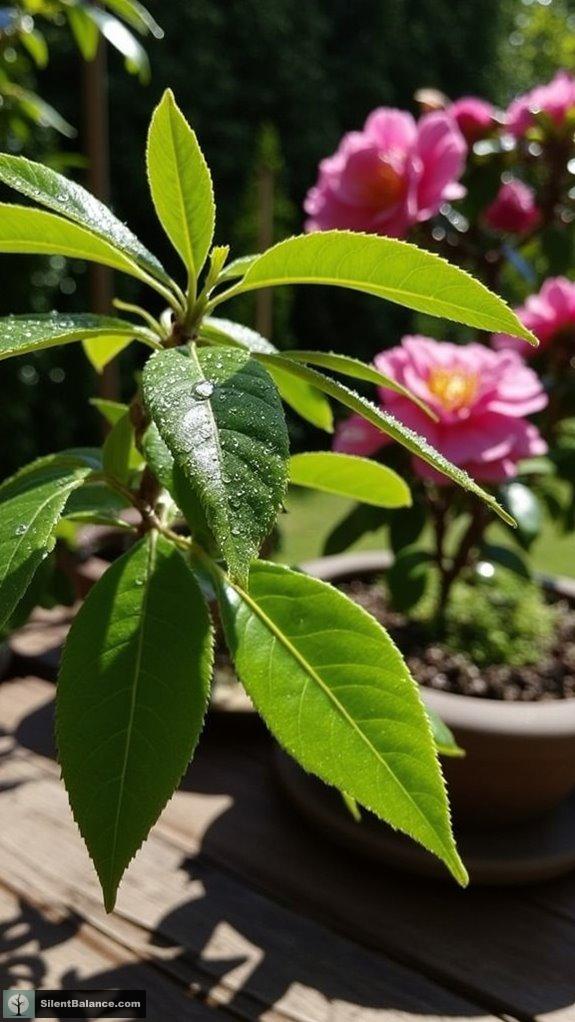
If you’ve ever wanted a bonsai that can take a bit of care but still shine with beauty, broadleaf evergreen species are truly a delightful choice. They offer lush foliage and stunning blooms, making your space feel alive.
Here are a few remarkable options:
| Species | Key Features | Care Tips |
|---|---|---|
| Little Ollie Olive | Small, bright green leaves | Full sun, moderate watering |
| Azalea Bonsai | Vibrant blooms in spring | Partial sun, daily watering |
| Camellia Bonsai | Glossy leaves & lovely flowers | Filtered light, moderate watering |
| Boxwood Bonsai | Dense foliage, great for style | Prune often, adaptable light |
| Holly Bonsai | Glossy leaves, seasonal interest | Moderate light, good drainage |
Which one calls to you? These beauties not only add charm, but they’re also easy to keep happy.
Dwarf Umbrella Tree (Schefflera Arboricola)
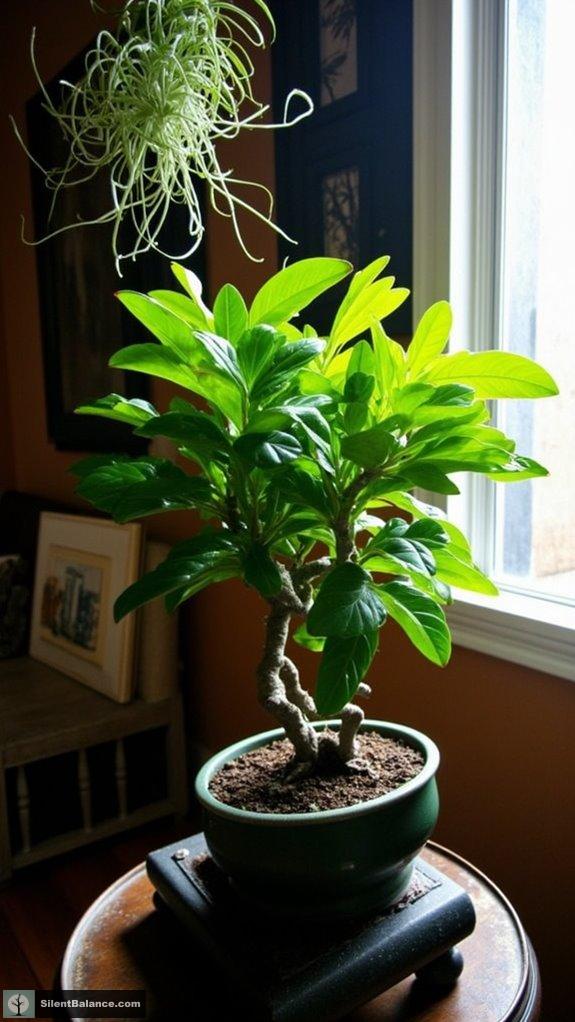
After basking in the verdant beauty of broadleaf evergreens, let’s shift gears and take a closer look at the Dwarf Umbrella Tree, or Schefflera Arboricola, which is an absolute gem for bonsai enthusiasts seeking a low-maintenance yet stunning specimen.
This sturdy little tree thrives in bright morning light but, like a diva, needs a break from harsh afternoon sun.
Watering? Keep it moist but avoid the soggy swamp—it’s a bonsai, not a bog!
I love misting the leaves daily; it keeps them happy and healthy, much like some good spa time.
And as for those pesky pests? A little soap solution goes a long way.
Are you ready to embrace this tropical beauty? You’ve got this!
Bonsai Tree Symbolism
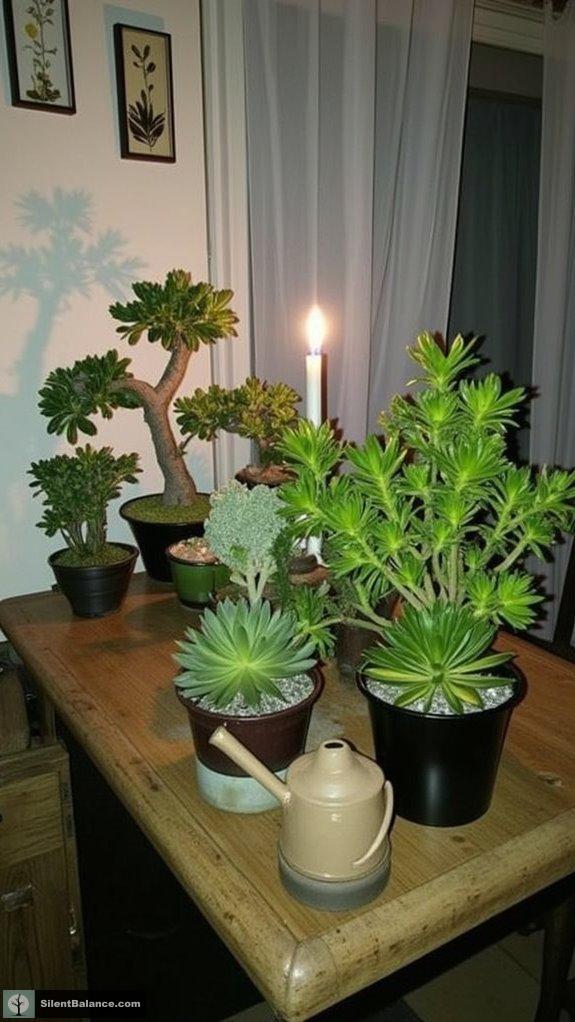
Bonsai trees aren’t just lovely little miniatures of the natural world; they pack a powerful punch when it comes to symbolism, too!
Imagine a Ficus bonsai, symbolizing unity and new beginnings—how perfect is that for starting fresh?
Or think about a Cherry Blossom bonsai, representing life’s fleeting beauty and feminine power.
Each species carries its own whispers of meaning, like a Jade bonsai inviting abundance into your space.
They’re more than just pretty plants; they remind us of patience and mindfulness, so we can embrace life’s little moments.
Ever thought of gifting one? An Azalea bonsai captures love and beauty effortlessly.
In a world that often rushes by, these trees beckon us to pause, reflect, and savor the growth in our lives.
Tree Symbolism

Tree symbolism runs deep in the domain of bonsai.
Take the Chinese Elm, for instance. It embodies strength and resilience, don’t you think? Its graceful structure suggests balance and serenity, much like a deep breath on a busy day.
How about the Ficus? This little gem stands for abundance and harmony, perfect for bringing good vibes into any space!
Then there’s the Ponytail Palm. With its elegance and independence, it’s like that friend who’s effortlessly cool.
And let’s not overlook the Jade Bonsai, symbolizing prosperity.
When you choose these species, you’re not just nurturing plants; you’re inviting profound meanings into your life.
Isn’t it magical how such tiny trees can hold such vast symbolism?
Questions and Answers
How Often Should I Fertilize My Bonsai Tree?
I fertilize my bonsai tree every 2-4 weeks during the growing season. For indoor varieties, I usually wait 4-6 weeks. I’ve learned to adjust based on how my tree responds and its specific needs.
What Is the Best Soil for Bonsai Trees?
Envision nurturing a tiny forest in your home. The best soil for my bonsai mixes akadama, pumice, and lava rock, creating a living tapestry that breathes, retains, and drains. It’s love woven into the earth.
Can I Keep Bonsai Trees Outdoors Year-Round?
You can definitely keep some bonsai trees outdoors year-round, but you’ve gotta pick the right species. Personally, I love the versatility of Chinese Elms— they thrive in varied climates and really enhance my outdoor space.
How Do I Identify Pests on My Bonsai?
To identify pests on my bonsai, I inspect leaves and branches closely for discoloration or webbing. I use a magnifying glass to spot tiny insects, and I shake foliage over white paper to catch any hidden pests.
What Tools Are Essential for Bonsai Care?
When tending my bonsai, I’ve found essential tools like shears, root cutters, and watering cans become my trusted companions. Each helps me nurture my leafy friend, creating a bond that flourishes with care and attention.
References
- https://miyagibonsai.co.uk/blog/bonsai-care/what-is-the-lowest-maintenance-bonsai-tree/
- https://bonsai2u.co.uk/top-5-bonsai-tree-gifts-that-are-easy-to-care-for/
- https://easternleaf.com/what-is-the-best-beginner-bonsai-tree/
- https://www.bonsainut.com/threads/best-and-worst-bonsai-for-beginners-like-me.57251/
- https://www.bonsaioutlet.com/beginner-bonsai-trees/
- https://www.bonsaioutlet.com/dwarf-jade-bonsai-care/
- https://bonsaibar.com/blogs/tree-care/summer-care-for-your-dwarf-jade
- https://www.bonsaiempire.com/tree-species/jade-tree
- https://www.youtube.com/watch?v=OADWeCQiAg8
- https://www.bonsaiempire.com/forum/help-me/22067-assistance-needed-on-my-portulacaria-afra
- https://bonsaimirai.com/species/ficus-bonsai
- https://blog.easternleaf.com/ficus-bonsai-tree-care/
- https://www.youtube.com/watch?v=85LmAwaEWKA
- https://www.bonsaioutlet.com/ficus-bonsai-care/
- https://www.livelyroot.com/blogs/plant-care/ficus-ginseng-care
- https://www.lovemybonsai.com/blogs/bonsai-care-sheets/how-to-care-for-your-chinese-elm-bonsai-tree
- https://www.bonsaiempire.com/tree-species/chinese-elm
- https://hookedonbonsai.com/a-comprehensive-chinese-elm-bonsai-care-guide/
- https://www.youtube.com/watch?v=7F5OTG7jHoc
- https://blog.easternleaf.com/chinese-elm-bonsai-tree-care-guide/
- Top 10 Bonsai Tree Designs for Miniature Home Greenery - September 5, 2025
- What Are the Easiest Bonsai Tree Species for Minimal Care? - September 5, 2025
- Best Bonsai Tree Species for Outdoor Seasonal Climates - September 5, 2025

